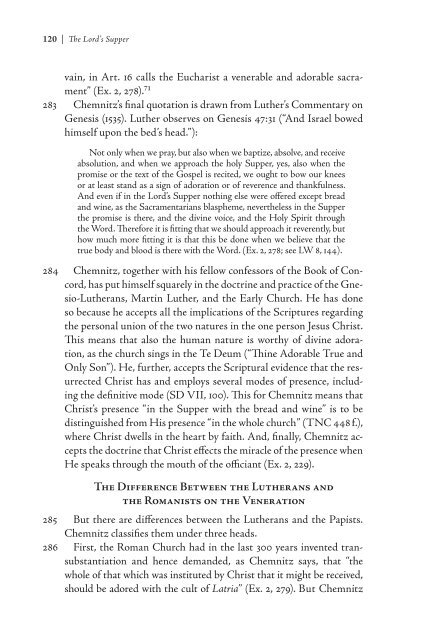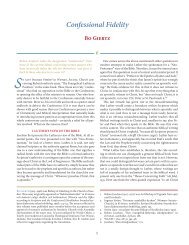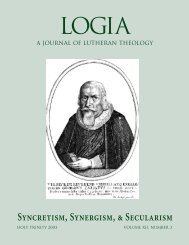The Lord's Supper in the Theology of Martin Chemnitz Bjarne - Logia
The Lord's Supper in the Theology of Martin Chemnitz Bjarne - Logia
The Lord's Supper in the Theology of Martin Chemnitz Bjarne - Logia
Create successful ePaper yourself
Turn your PDF publications into a flip-book with our unique Google optimized e-Paper software.
0 | <strong>The</strong> Lord’s <strong>Supper</strong><br />
va<strong>in</strong>, <strong>in</strong> Art. 16 calls <strong>the</strong> Eucharist a venerable and adorable sacrament”<br />
(Ex. 2, 278). 71<br />
283 <strong>Chemnitz</strong>’s f<strong>in</strong>al quotation is drawn from Lu<strong>the</strong>r’s Commentary on<br />
Genesis (1535). Lu<strong>the</strong>r observes on Genesis 47:31 (“And Israel bowed<br />
himself upon <strong>the</strong> bed’s head.”):<br />
Not only when we pray, but also when we baptize, absolve, and receive<br />
absolution, and when we approach <strong>the</strong> holy <strong>Supper</strong>, yes, also when <strong>the</strong><br />
promise or <strong>the</strong> text <strong>of</strong> <strong>the</strong> Gospel is recited, we ought to bow our knees<br />
or at least stand as a sign <strong>of</strong> adoration or <strong>of</strong> reverence and thankfulness.<br />
And even if <strong>in</strong> <strong>the</strong> Lord’s <strong>Supper</strong> noth<strong>in</strong>g else were <strong>of</strong>fered except bread<br />
and w<strong>in</strong>e, as <strong>the</strong> Sacramentarians blaspheme, never<strong>the</strong>less <strong>in</strong> <strong>the</strong> <strong>Supper</strong><br />
<strong>the</strong> promise is <strong>the</strong>re, and <strong>the</strong> div<strong>in</strong>e voice, and <strong>the</strong> Holy Spirit through<br />
<strong>the</strong> Word. <strong>The</strong>refore it is fitt<strong>in</strong>g that we should approach it reverently, but<br />
how much more fitt<strong>in</strong>g it is that this be done when we believe that <strong>the</strong><br />
true body and blood is <strong>the</strong>re with <strong>the</strong> Word. (Ex. 2, 278; see LW 8, 144).<br />
284 <strong>Chemnitz</strong>, toge<strong>the</strong>r with his fellow confessors <strong>of</strong> <strong>the</strong> Book <strong>of</strong> Concord,<br />
has put himself squarely <strong>in</strong> <strong>the</strong> doctr<strong>in</strong>e and practice <strong>of</strong> <strong>the</strong> Gnesio-Lu<strong>the</strong>rans,<br />
Mart<strong>in</strong> Lu<strong>the</strong>r, and <strong>the</strong> Early Church. He has done<br />
so because he accepts all <strong>the</strong> implications <strong>of</strong> <strong>the</strong> Scriptures regard<strong>in</strong>g<br />
<strong>the</strong> personal union <strong>of</strong> <strong>the</strong> two natures <strong>in</strong> <strong>the</strong> one person Jesus Christ.<br />
This means that also <strong>the</strong> human nature is worthy <strong>of</strong> div<strong>in</strong>e adoration,<br />
as <strong>the</strong> church s<strong>in</strong>gs <strong>in</strong> <strong>the</strong> Te Deum (“Th<strong>in</strong>e Adorable True and<br />
Only Son”). He, fur<strong>the</strong>r, accepts <strong>the</strong> Scriptural evidence that <strong>the</strong> resurrected<br />
Christ has and employs several modes <strong>of</strong> presence, <strong>in</strong>clud<strong>in</strong>g<br />
<strong>the</strong> def<strong>in</strong>itive mode (SD VII, 100). This for <strong>Chemnitz</strong> means that<br />
Christ’s presence “<strong>in</strong> <strong>the</strong> <strong>Supper</strong> with <strong>the</strong> bread and w<strong>in</strong>e” is to be<br />
dist<strong>in</strong>guished from His presence “<strong>in</strong> <strong>the</strong> whole church” (TNC 448 f.),<br />
where Christ dwells <strong>in</strong> <strong>the</strong> heart by faith. And, f<strong>in</strong>ally, <strong>Chemnitz</strong> accepts<br />
<strong>the</strong> doctr<strong>in</strong>e that Christ effects <strong>the</strong> miracle <strong>of</strong> <strong>the</strong> presence when<br />
He speaks through <strong>the</strong> mouth <strong>of</strong> <strong>the</strong> <strong>of</strong>ficiant (Ex. 2, 229).<br />
<strong>the</strong> Difference Between <strong>the</strong> Lu<strong>the</strong>rans and<br />
<strong>the</strong> romanists on <strong>the</strong> veneration<br />
285 But <strong>the</strong>re are differences between <strong>the</strong> Lu<strong>the</strong>rans and <strong>the</strong> Papists.<br />
<strong>Chemnitz</strong> classifies <strong>the</strong>m under three heads.<br />
286 First, <strong>the</strong> Roman Church had <strong>in</strong> <strong>the</strong> last 300 years <strong>in</strong>vented transubstantiation<br />
and hence demanded, as <strong>Chemnitz</strong> says, that “<strong>the</strong><br />
whole <strong>of</strong> that which was <strong>in</strong>stituted by Christ that it might be received,<br />
should be adored with <strong>the</strong> cult <strong>of</strong> Latria” (Ex. 2, 279). But <strong>Chemnitz</strong>




